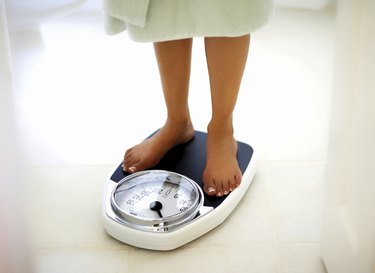How to Calculate Ideal Body Weight in Pounds

Knowing your ideal body weight will help you in your goal to lose or gain weight.
Image Credit: stevecoleimages/E+/Getty Images
If you're trying to lose or gain weight, knowing your ideal body weight can help you determine a goal. You can use a simple equation to figure out your ideal body weight, or IBW, but other considerations are important as well if you want to stay healthy. For example, how much body fat you have and where you carry it make a difference in your risk for heart disease and other health problems. Your doctor can advise you on the best weight for your health.
Calculating Ideal Body Weight
Your ideal body weight, or IBW, depends on both your sex and height. For men, ideal body weight is calculated by using 106 pounds for the first 5 feet of height and adding 6 additional pounds for each inch.
For women, the ideal body weight calculation starts with 100 pounds for the first 5 feet of height, then you add 5 pounds for each additional inch. If you're under 5 feet tall, subtract 2 pounds for each inch under 5 feet.
Using the equation, a 5-foot, 4-inch tall woman would have an ideal weight of 120 pounds: IBW = 100 + (4 x 5) = 120.
A man who is 6 feet tall has an IBW of 178 pounds: IBW = 106 + (12 x 6) = 178.
Effect of Frame Size on Ideal Weight
Your body frame size helps determine your IBW, too. The equation above calculates the IBW for someone with a medium frame. You can subtract 10 percent for a person of the same height with a small frame, and add 10 percent for a large-framed individual. So in the end, you end up with an IBW range.
For example, for the 5-foot, 4-inch tall woman in the first example with an IBW of 120 pounds, her IBW range is 108 to 132 pounds. A healthy weight for small-framed woman of this height would be toward the low end of 108 pounds, while a large-framed woman could weigh toward the high end. And the man who's 6 feet tall has an IBW range of 160 to 196 pounds.
If you're not sure of your frame size, here's a quick way to figure it out. Place your thumb and middle finger around your wrist, right where you'd wear a watch. If your fingers overlap, you have a small frame. If they touch, your frame is medium and if they don't meet, you have a large frame.
A Healthy Weight Range by BMI
You may have heard of body mass index, or BMI, and wonder if it has anything to do with your IBW. BMI is a number calculated from your height and weight. It's a tool doctors use to assess if people are at a healthy weight. A BMI between 18.5 and 24.9 is considered healthy. Higher BMIs fall into the overweight or obesity range.
You can plug your height and weight into an online BMI calculator to get your BMI number. Or you can calculate it yourself with this equation, using your weight in pounds and your height in inches: BMI = (weight x 703) / (height x height)
To calculate the BMI of the 5-foot, 4-inch woman who weighs 120 pounds: (120 x 703) / (64 x 64) = 20.6. This puts her weight in the healthy range.
The National Institutes of Health has an adult BMI chart that shows a weight range based on height and BMI. You can look on the chart beside your height and see what a healthy weight range is for you. If you're 5-foot, 4-inches tall, your healthy weight range is 110 to 140 pounds. This differs slightly from the IBW range of 108 to 132.
Checking Your Waist Size
Neither the IBW calculation nor BMI take weight distribution into account. Knowing another metric — your waist measurement — can provide more information about your health by assessing your belly fat.
If you have a larger waist, it means you have too much visceral fat, an unhealthy type of fat that surrounds your organs and pushes your belly outward. An abundance of visceral fat can increase your risk for heart disease and other health problems.
If you're a woman, your waist circumference shouldn't be more than 35 inches, and if you're a man, try to keep it below 40 inches.
Considering Body Fat Percentage
It's possible to be at a healthy weight but have too much body fat. This condition, called normal-weight obesity, can increase your risk for high cholesterol, high blood pressure and heart disease.
Up to 31 percent body fat is considered acceptable for women, with female athletes and fit women having 14 to 24 percent body fat, according to the American Council on Exercise. For men, ACE considers up to 24 percent body fat acceptable, with athletic and fit men falling between 6 and 17 percent body fat.
To gauge your body fat percentage, you can have a trained professional measure your body fat with skinfold calipers or with bioelectrical impedance analysis, or BIA, using a handheld scanner, both of which are available at some gyms. BIA involves having a painless electrical signal transmitted through your body. Because fat slows down electrical signals, the time it takes the signal to pass through the body can help estimate body fat. Other more accurate ways to measure body fat exist, but they are expensive and require special equipment.
How to Calculate Ideal Body Weight in Pounds
Source: https://www.livestrong.com/article/281134-how-to-calculate-ibw/#:~:text=For%20men%2C%20ideal%20body%20weight,pounds%20for%20each%20additional%20inch.